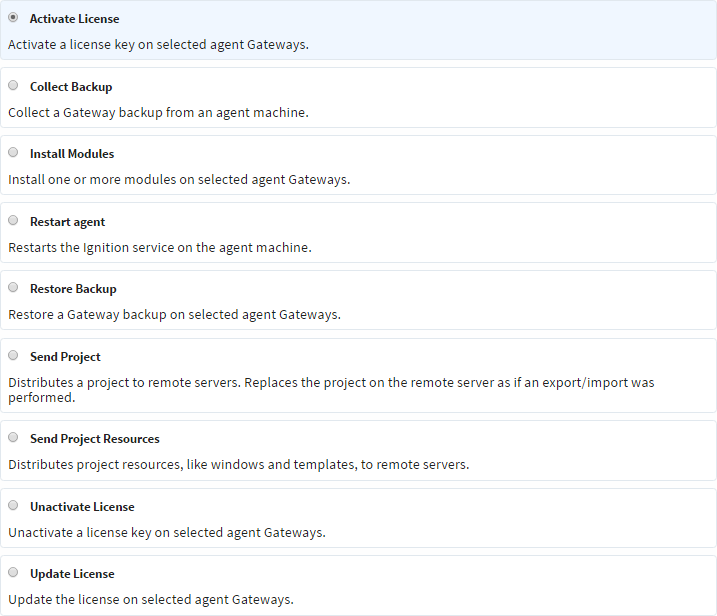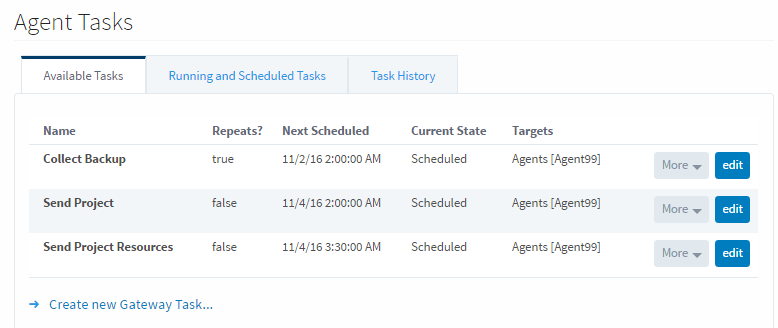Enterprise Administration
What is Enterprise Administration?
The Enterprise Administration Module (EAM) allows a user to control and monitor any number of Ignition Gateways from a central Gateway. The EAM takes advantage of the Gateway Network system to seamlessly deliver data between Gateways.
Benefits of EAM
EAM works great in systems with multiple Gateways. EAM is not required for large Ignition systems, but there are several benefits to incorporating the module:
-
Gateway Version Control - Upgrade modules on each Gateway to ensure each installation is on the same version.
-
Project Synchronization - In cases where the same project is used on multiple Gateways, making updates to the project on each other Gateway is a hassle. With EAM, projects can automatically be pushed to select agents, greatly hastening how updates are pushed out.
-
Monitor Agent Health - Overseeing the health of large systems can be a full-time job. With EAM, the controller monitors agent health, and will trigger alarms when an issue arises, such as high CPU or memory usage. Alarm notifications can also be sent, so you will always know immediately when an issue is detected.
-
Quick Recovery from System Failures - Hardware failure can cause days of downtime. Agent Recovery allows for quick Gateway, license, and module restoration on new hardware to greatly reduce the amount of time the system is down.
What are Agents and Controllers?
EAM involves coordinating several different Gateways on the same network. Each Gateway is assigned a role:
-
Controller - Manages or controls each others connected Gateway. The Controller is responsible for assigning tasks, as well as monitoring each agent. Only a single Gateway on each Gateway network can be a controller.
-
Agent - Each other Gateway in the Gateway network is an agent. Agents perform all assigned tasks, and report to the controller.
Task Management
EAM allows you to schedule common Gateway tasks to execute against remote agent Gateways. Tasks are requests sent to an Agent by the Controller. These requests cause the agent to perform some action such as activating a license. Tasks include:

On-Demand or Scheduled
Tasks can be executed immediately, scheduled to run once at a later time, or as part of a recurring schedule. Making backups is a breeze with automated task scheduling! Schedules can be freely modified or paused. Scheduled tasks can also execute on-demand, allowing the tasks to be called at will.

Disaster Recovery and Prevention
Agent Events
Every EAM agent sends information to the controller about its general health status. Whenever problems occur on an agent, the controller is notified of the agent’s status in the form of agent events. Problems can include high CPU usage on the agent, large numbers of system errors in a short timeframe, and unusually high usage of database connections. Loss of connectivity to the agent also triggers an agent event on the controller. Agent events are recorded in an external database for analysis and reporting later. Agent events can also be directly configured on the controller to automatically trigger alarms or send alarm notifications.
Archival and System Recovery
The Collect Backup Gateway task does more than simply collect a Gateway backup from agents. Whenever the task runs, the Gateway backup, all installed modules and the current license are collected from the agent and stored in the archive system on the controller. This system allows for quick recovery later if an agent machine catastrophically fails and must be reinstalled.
In This Section ...